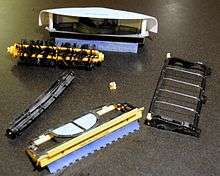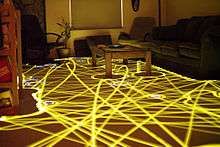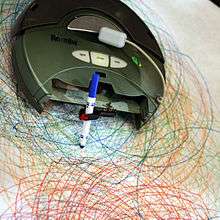Roomba

Roomba is a series of autonomous robotic vacuum cleaners sold by iRobot. Introduced in September 2002,[1] Roomba features a set of basic sensors that enable it to perform its tasks. For instance, the Roomba is able to change direction upon encountering obstacles, to detect dirty spots on the floor, and to sense steep drops to keep it from falling down stairs. It uses two independently operating wheels that allow 360° turns in place. Additionally, it can adapt to perform other, more creative tasks, using an embedded computer in conjunction with the Roomba Open Interface.
Description

All Roomba models are disc-shaped, 34 cm (13") in diameter and less than 9 cm (3.5") high. A large contact-sensing mechanical bumper is mounted on the front half of the unit, with an omnidirectional infrared sensor at its top front center. A recessed carrying handle is fitted on the top of most units.[2]
As of 2016, there have been seven generations of Roomba units: The first-generation Original Series, the second-generation 400 and Discovery Series, the third-generation Professional and 500 Series, the fourth-generation 600 Series, the fifth-generation 700 Series, the sixth-generation 800 Series, and the seventh-generation 980 model.[3] All models have a pair of brushes, rotating in opposite directions, to pick up debris from the floor. In most models, the brushes are followed by a squeegee vacuum, which directs the airflow through a narrow slit to increase its speed in order to collect fine dust. A horizontally mounted "side spinner" brush on the right side of the unit sweeps against walls to reach debris not accessible by the main brushes and vacuum. In the first generation of robots, the dirty air passes through the fan before reaching the filter, while later models use a fan-bypass vacuum.
The Roomba is powered by a removable NiMH battery, which must be recharged regularly from a wall power adapter. Newer second- and third-generation models have a self-charging homebase that the unit seeks out at the end of a cleaning session via infrared beacons. Charging on the homebase takes about three hours. Four infrared "cliff sensors" on the bottom of the Roomba prevent it from falling off ledges such as stairways. Most second- and third-generation models have internal acoustic-based dirt sensors that allow them to detect particularly dirty spots and focus on those areas accordingly. Fourth-generation models have an optical sensor located in front of the vacuum bin, allowing detection of wider and smaller messes.[4] Many second- and third-generation Roombas come packaged with infrared remote controls, allowing a human operator to "drive" the robot to areas to be specially cleaned.
Some higher-end 500, 700 and 800 series robots are compatible with Virtual Wall Lighthouses,[5] which use radio signals to communicate. These more advanced accessories confine a Roomba to a fixed area to be cleaned, yet allow the robot to later proceed to the next space which needs to be cleaned.[6]
There are several types of dust and debris collection bins for he 500 series robots. The standard vacuum bin incorporates a squeegee vacuum. The high-capacity sweeper bin does not include a vacuum, but has greater debris capacity. The Aerovac Bin directs suction airflow through the main brushes instead of using a squeegee, which is thought to keep the brushes cleaner.
Operation

All Roomba models can be operated by manually carrying them to the room to be cleaned and pressing a button. Later models introduced several additional operating modes. "Clean" mode is the normal cleaning program, starting in a spiral and then following a wall, until the room is determined to be clean. "Spot" mode cleans a small area using an outward-then-inward spiral. "Max" mode runs the standard cleaning algorithm until the battery is depleted. "Dock" mode, introduced with the third generation, instructs the robot to seek a charging base for recharging. The availability of the modes varies by model.
The robot's bumper allows it to sense when it has bumped into an obstacle, after which it will reverse or change paths. The third- and fourth-generations, which move faster than previous models, have additional forward-looking infrared sensors to detect obstacles. These slow down the robot when nearing obstacles, to reduce its force of impact.[7] This technology is also able to distinguish between soft and solid barriers. After enough time cleaning or as the battery runs down, the Roomba will either search for and dock with the base, or stop where it is.
The cleaning time depends on room size and, for models equipped with dirt sensors, volume of dirt. First-generation models must be told the room size, while second- and third-generation models estimate room size by measuring the longest straight-line run they can perform without bumping into an object. When finished cleaning, or when the battery is nearly depleted, a second- or third-generation Roomba will try to return to a base if one is detected. A second-generation Roomba may also be used with a scheduler accessory, allowing cleaning to start at the time of day and on days of the week that the owner desires. Most 500 Series robots support scheduling through buttons on the unit itself, and higher-end models allow the use of a remote to program schedules.
Roombas do not map out the rooms they are cleaning. Instead, iRobot developed a technology called iAdapt Responsive Cleaning Technology.[8] Roombas rely on a few simple algorithms, such as spiral cleaning (spiraling), room crossing, wall-following and random walk angle-changing after bumping into an object or wall. This design is based on MIT researcher and iRobot CTO Rodney Brooks' philosophy that robots should be like insects, equipped with simple control mechanisms tuned to their environments. The result is that although Roombas are effective at cleaning rooms, they take several times longer to do the job than a human would. The Roomba may cover some areas many times, and other areas only once or twice. The virtual wall accessories project beams, which the Roomba will not cross.
The Roomba is not designed for deep-pile carpet. Also, the first- and second-generation Roombas can get stuck on rug tassels and electrical cords. The third-generation is able to reverse its brushes to escape entangled cords and tassels. Additionally, all models are designed to be low enough to go under a bed or most other items of furniture. If at any time the unit senses that it has become stuck, no longer senses the floor beneath it, or it decides that it has worked its way into a narrow area from which it is unable to escape, it stops and sounds an error to help someone find it. Early models use only flashing lights to indicate specific problems, while later models use a synthesized voice to announce a problem and a suggested solution.[9]
Battery life
Battery reliability is a frequently mentioned complaint on customer review websites. Battery replacements from iRobot cost a significant fraction of the purchase price of a new Roomba, though compatible third-party batteries are available at a lower price. The iRobot customer support website offers advice on maximizing battery performance and longevity.[10]
Models
Original and 400 series
Introduced in September 2002, the first-generation Roomba had three buttons for room size. The first-generation units comprised the original silver-colored Roomba, the blue Roomba Pro, and the maroon Roomba Pro Elite. The latter two models included additional accessories, but all three used the same core robot and cleaning system. The second-generation Roombas ("Discovery", later called 400 series) replaced their predecessors in July 2004, added a larger dust bin, improved software that calculates room size, dirt detection, and fast charging in the home base.
Roomba budget models (Dirt Dog and Model 401) used a simplified interface (a single button) and lacked some of the software-controlled flexibility of other versions. They were less expensive models intended for first-time purchasers. The Roomba Dirt Dog contained sweeping brushes and a larger dust bin, but lacked the vacuum motor, using the space that would be required for the vacuum for additional dust bin volume. It was designed for a home shop or garage environment.[5] The Roomba Model 401 was similar but had a standard-size dust bin and vacuum system. The Dirt Dog was discontinued in 2010.
500 and 600 series
The third-generation 500 series Roomba was introduced in August 2007[5] and featured a forward-looking infrared sensor to detect obstacles and reduce speed, a docking command button, improved mechanical components, smoother operation, and a modular design to facilitate part replacement.[5][11] It also introduced customizable decorative face plates.[5] The Roomba 530 included two virtual walls and a recharging dock.[5] In August 2012, the 500 series was superseded by the 600 series, which added the aerovac bin and advanced cleaning head as standard features. In 2017 they released the 690, which has WiFi connectivity so it can be started with an app and various personal-assistant software.[12]
700 series
The 700 series, introduced in May 2011, though largely similar to the 500 and 600 series, included improvements of a more robust cleaning system, improved aerovac bin with HEPA filter, and improved battery life. Like the 500 series, the 700 series included robots with different technologies and accessories. The Roomba 760 was the simplest of the robots, and Roomba 790[13] was the second newest, with both scheduling and a large range of accessories including lighthouses, wireless command center, and extra brushes and filters. Besides these two models, Roomba 770 and 780 were available, with scheduling, dirtdetect, and full bin indicator.
800 series
The 800 series, introduced in 2013, is similar to the 700 series and its predecessors, but contains updated technology. The aeroforce performance cleaning system, which is five times more powerful than older series,[14] and the iRobot XLife battery are some of the new features. The aeroforce system does away with the large rotating brush, but pulls air between two rubber rollers, thereby getting the vacuum suction closer to the floor. In 2017 iRobot released the 890 with WiFi connectivity that can be started with an app and various personal-assistant software.[15]
900 series
The Roomba 980 was released in September 2015, and contains a new visual simultaneous localization and mapping (vSLAM) navigation system,[16] which allows it to clean an entire level of a home more efficiently. The 980 also features Wi-Fi connectivity and an iPhone and Android app.[17] As of March 29, 2017, 900 series users can receive detailed cleaning maps of their Roomba through the app. The maps show exact areas of clean and dirty spots in the home, allowing the Roomba to know where it needs to spend more time cleaning. Push notifications of when the Roomba is finished cleaning is also a new feature. Integration to Amazon’s Alexa was also announced, launching in spring 2017.[18]
Hacking and extending Roomba

From the earliest models on, Roomba vacuum cleaning robots have been hacked to extend their functionality. The first adaptations were based on a microcontroller that was directly connected to the motor drivers and sensors.[19] Versions manufactured after October 2005 contain an electronic and software interface that allows hackers to more easily control or modify behavior and remotely monitor its sensors.[20] One early application was using the device to map a room.[21] The native code for Roomba is written in a dialect of Lisp.[22]
Models with an interface (400 series since October 2007 plus 500 and 700 series) come with a Mini-DIN connector supporting a serial interface, which is electrically and physically incompatible with standard PC/Mac serial ports and cables. However, third-party adapters are available to access the Roomba's computer via Bluetooth, USB, or RS-232 (PC/Mac serial).[23] Roombas pre-October 2005 upgraded with the OSMO hacker[24] device allow monitoring many sensors and modifying the unit's behavior. The Roomba open interface (formerly Roomba serial command interface) allows programmers and roboticists to create their own enhancements.[25][26] Several projects are described on Roomba hacking sites.[27]
In response to the growing interest of hackers in their product, the company developed the iRobot Create. In this model the vacuum cleaner motor is replaced by a "cargo bay" for mounting devices like TV cameras, lasers and other robotic parts. It provides a greatly enhanced 25-pin interface providing both analog and digital bidirectional communication with the hosted device allowing use as the mobile base for completely new robots. Together with a computing platform like a netbook or handheld device with wireless networking, it can be remotely controlled through a network.[28]
See also
- Comparison of domestic robots
- Domestic robot
- List of vacuum cleaners
- Robotic mapping
- Robotics suite
- Scooba floor washer, iRobot's second home robot
References
- ↑ "iRobot Corporation:Our History". Irobot.com. Retrieved 2013-11-24.
- ↑ "iRobot Roomba 560 Video Review". Robot Reviews. Retrieved 18 September 2013.
- ↑ "iRobot Store". iRobot. Retrieved 30 May 2015.
- ↑ "What is Roomba's Dirt Detect technology?". Uksupport.irobot.com. Retrieved 2013-01-29.
- 1 2 3 4 5 6 Archived September 15, 2011, at the Wayback Machine.
- ↑ "What are Roomba® Virtual Walls®?". iRobot Customer Care. iRobot. Retrieved 2012-03-04.
- ↑ "iRobot: Customer Care - Roomba® 500/600/700 Series Light Touch Technology". Homesupport.irobot.com. Retrieved 2013-01-29.
- ↑ https://web.archive.org/web/20130511232754/http://www.irobot.com/EngineeringAwesome/images/iAdapt%20Fast%20Facts.pdf
- ↑ "How can I prevent Roomba from getting stuck?". iRobot Customer Care. iRobot. Retrieved 2012-03-04.
- ↑ "Roomba® 500/600/700 Series Battery Maintenance Tips". iRobot Customer Care. iRobot. Retrieved 2012-03-04.
- ↑ "Official iRobot Website". Homesupport.irobot.com. Retrieved 2009-06-09.
- ↑ http://media.irobot.com/2017-05-02-iRobot-Extends-Wi-Fi-Connectivity-with-New-Roomba-R-890-and-690-Vacuuming-Robots
- ↑ "iRobot Corporation: Roomba 790". Irobot.com. Retrieved 1 July 2012.
- ↑ "Bobsweep vs Roomba vs Neato – Robotic Vacuum Cleaners Battle! — Sevenhints". Sevenhints. 2017-03-14.
- ↑ http://media.irobot.com/2017-05-02-iRobot-Extends-Wi-Fi-Connectivity-with-New-Roomba-R-890-and-690-Vacuuming-Robots
- ↑ "Roomba 960 and 980". Leads Rating, January 04, 2017, by Jeremy Jauncey
- ↑ "Roomba 980." http://www.irobot.com/For-the-Home/Vacuuming/Roomba.aspx.
- ↑ McFarland, Matt (2017-03-15). "Roomba will now tell you what part of your home is dirtiest". CNNMoney. Retrieved 2017-03-29.
- ↑ "Discussing and Dissecting the Roomba 780 ad Scooba 230". Roomba Community. Retrieved 2012-03-04.
- ↑ "iRobot Roomba Serial Command Interface (SCI) Specification" (PDF). Irobot.com. Retrieved 2013-11-24.
- ↑ Gerkey, Brian (2006-03-31). "Robotic mapping for Roomba". Artificial Intelligence Center. SRI International. Retrieved 2013-06-13.
- ↑ "Why Lisp?".
- ↑ "Roomba Development Tools". Archived from the original on 2006-07-11. Retrieved February 1, 2007.
- ↑ "OSMO - RoombaDevTools.com". Web.archive.org. 2007-01-15. Archived from the original on January 15, 2007. Retrieved 2013-11-25.
- ↑ "iRobot Roomba Serial Command Interface (SCI) Specification" (PDF). iRobot Corporation. October 2005. Retrieved February 1, 2012.
- ↑ "iRobot Corporation: Roomba Open Interface" (PDF). iRobot. 2006. Retrieved 2015-09-07.
- ↑ "Roomba hacking projects". Hackingroomba.com. Retrieved February 6, 2013.
- ↑ "Roomba Robot project". Irobot.com. Retrieved 2012-03-04.
External links
| Wikimedia Commons has media related to Roomba. |
- iRobot.com, manufacturer and retailer of Roomba in the United States
- RobotReviews.com, The largest and most active discussion site for Roomba users
- C# RoombaSCI, Open Source C# Programming Framework for Roomba
- Roomba Tear Down Guide, Step-By-Step Roomba Tear Down and Repair
- Comprehensive guide to programming Roomba, Comprehensive guide to programming Roomba (with code examples)
- Roomote iOS app for controlling Roomba via serial or Bluetooth connection
- Roomba Repair Guide, information about common bump sensor error (9-beep error)